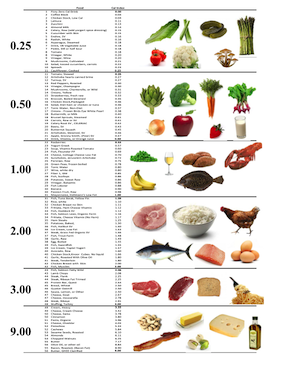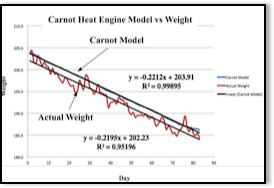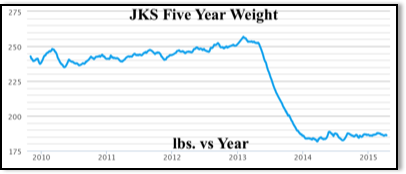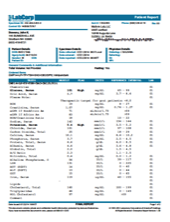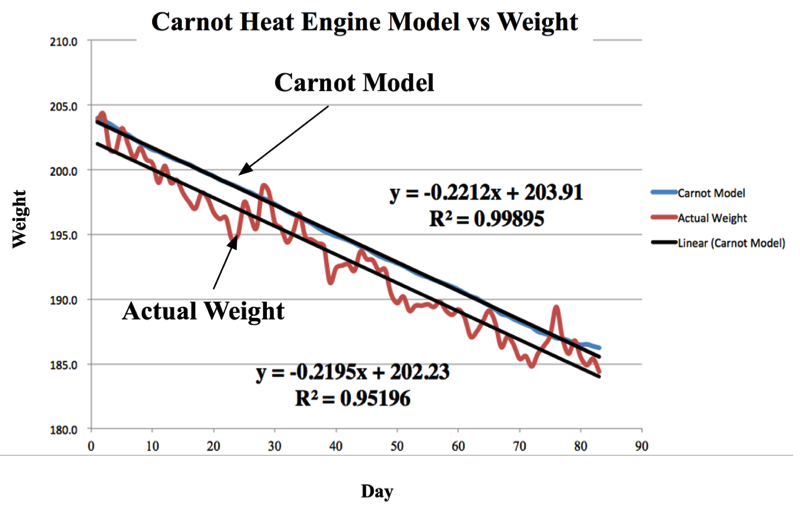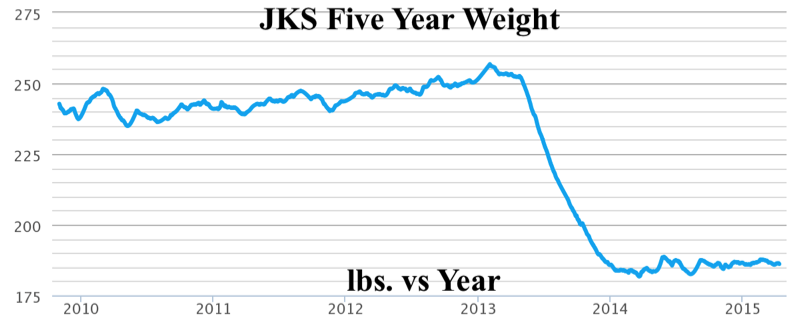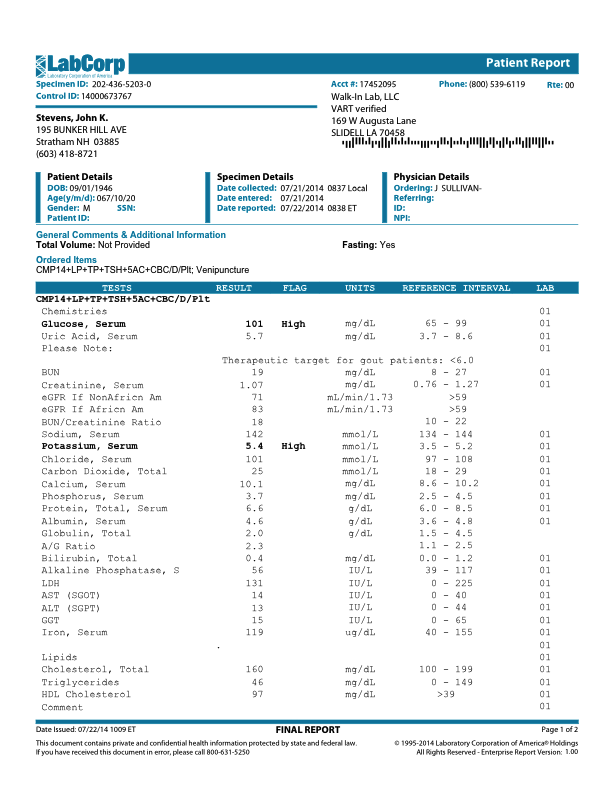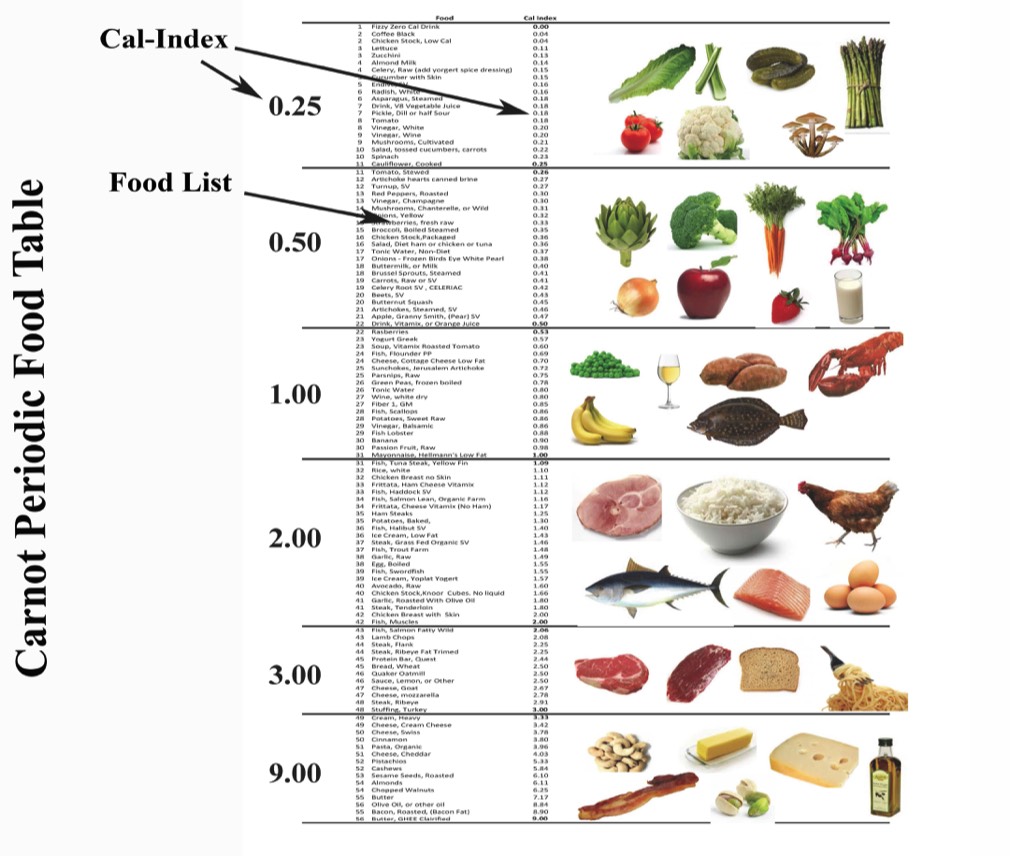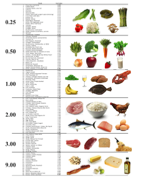The Carnot Diet Is A Simple, Sustainable Weight Management Plan.
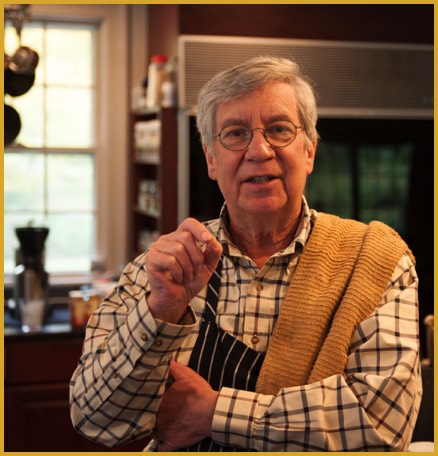
You Lose Weight Because of Simple Physics"
I am going to show you how I got thin, and introduce you to the Carnot Diet Plan. Carnot (pronounced "kahr-noh") is weight management based on fundamental, but simple physics. Carnot is a rational diet that works because it is based on science that has withstood over 250 years scrutiny, and new 21st century cooking technology that makes cooking, dieting and long term weight management easy.
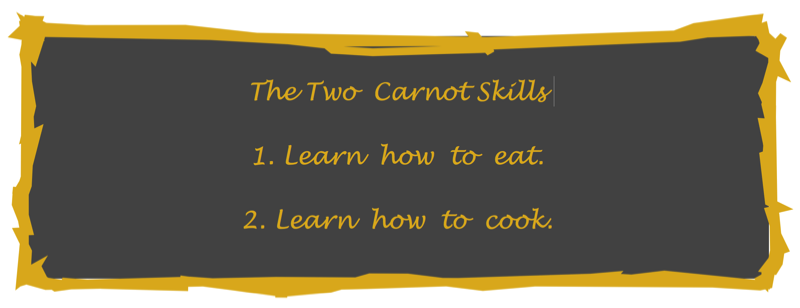
Let's Get Started. We start by introducing a universal physical food constant the Cal-Index, or CI. The CI is number of calories any food contains per gram of weight - it is a foods' energy density in calories/gram. For example a Tomato has a CI=0.16 cal/gram. Some other examples; Asparagus 0.18; Yellow Squash 0.22; Broccoli 0.35; Carrots 0.41; Banana 0.90; Haddock 1.12; Salmon 1.72; Chicken with Skin 2.0; Whole Wheat Bread 2.50; Ribeye Steak 2.91; Almonds 6.11; Butter or Olive Oil 9.0; The CI of any food is easy to calculate, and has a range of 0.00 to 9.00. As you learn CI's of the foods you eat you will be surprised maybe even shocked about caloric content of some foods. If place your food on a kitchen digital scale that gives weight in grams, you can calculate the caloric content simply by multiplying the CI times the weight. So 200 grams of Asparagus, a very large helping, with a CI of 0.18 is a total only 36 calories. If you add 10 grams of butter, just a tiny slice you just added 90 calories for a total of 126 calories. It is simple, as the CI goes down you get to eat more and still can eat less than you burn.
We provide the CI for 7,900 USDA listed foods in the USDA Tab. Take a moment and look at this link, The Carnot Periodic Table (CPT). The CPT ranks about 56 common foods you might eat using the CI - it is your introductory guide to selecting foods. Eventually you will create your own personal table, based on what you actually eat using Joule.
The Carnot Diet is a simple diet: 1. Keep your average CI for the day below 1.00; and 2. Eat less than you burn. You manage the CI and total calories-in using an open source google spreadsheet program Joule (see Joule Manual). Finally, we teach you to cook simple gourmet healthy meals using "hunger suppressing ingredients", using the latest cooking technology. Typical Carnot meals can take minutes to prepare or can be prepared in advance, often can be stored for months. Carnot is not about calorie counting, its all about caloric calibration so you know what and how much your eating.
The Carnot Periodic Table (CPT)
Click on Image to Make Large
Print CPT - Put on Refrigerator Door
For PDF Click Here. The CPT of Food is based on a physical constant - the Cal-Index of each food. If you select foods based on that constant and keep track of food weight in grams, it is easy to calculate daily calories consumed. You will create and manage your own CPT in Joule (Called Carnot Daily Table). I explain rationale for Cal-Index in a brief to USDA
Many confuse eating healthy and staying healthy and exercise with dieting… Obesity is like just cancer, it is lethal and life treating - weight loss from an obese state has many short term side effects just like chemotherapy does when treating cancer. Once your weight is lost and your thin, great to focus on healthy eating and staying fit.. but short term you must have only one goal - eliminate that adipose tissue get rid of the fat - lose fat and get weight down to normal values, nothing else will have bigger impact on your health or produce a better outcome.
Weight gain is all about biology. The biology of weight control and obesity is complex; in fact after 150 years of research, hundreds of journals and tens of thousands published studies we still are arguing about the causes of obesity. Read "Why We Get Fat", Gary Taubes, for an excellent up-to-date review of scientific literature. Some recent data suggests both your genes and the resident bacteria in your gut may contribute to obesity (see Sonnenberg, "The Good Gut").
So we do not agree how and why people become overweight - why we get fat is a science mystery, yet obesity may be the most expensive and largest health crisis ever seen on this planet. Obesity is insidious, because it does not lead to sudden death, it just leads to about a dozen chronic expensive diseases (see CDC Obesity Guidelines) that slowly kill; and 35% of the US population are Class I or above obese, while 66% of Americans are overweight, at an estimated cost of over $250B/year (see CDC Obesity Statistics).
However, forget about the past and why your fat now - the question we answer here "Why We Get Thin" has a simple answer: it is physics. Weight loss is simple physics and that fact is not in dispute - If you Eat less than you burn you will lose weight. Your body is a Carnot Heat Engine and obeys the 1st and 2nd law of thermodynamics. Nicolas Carnot (Paris 1796-1832) is the father of thermodynamics. He discovered the Heat Engine and the 2nd law of thermodynamics. James Prescott Joule developed the 1st Law of Thermodynamics. Those two laws and the Human Carnot Heat Engine make the physics of weight loss simple;
If you eat less than you burn you will lose weight and if you use Cal-Index as a guide you will be healthy and in much less pain as you lose weight.
All diets known to humankind that work (e.g. VB6, Mayo-Clinic, Atkins, South Beach, Weight Watchers, Nutrisystem, Jenny Craig, Juice Reboot, HCG) end up being calorically reduced programs. Most try take advantage of a current biological theory based how we gained the weight, but in reverse (e.g. low carbs, high protein no fat) - They all try to minimize the hunger pain, and sugar coat that they are calorically reduced diets. However, in the end the science shows (see Strychar for excellent review) to lose weight you must eat less than you burn, and when analyzed that's what all gimmick diets do, and most gain all weight back within 2-5 years with any of the gimmick "fat reversal" diets.
One apparent biological contradiction that has confused the science of diet - Many humans appear to have the ability to eat more than they burn and do not gain weight - they eat like a horse but don't get fat - that's because of their biology (see Sims 1967). Some recent data suggests both your genes and the resident bacteria in your gut may contribute to thinness or to obesity (see Sonnenberg, "The Good Gut"). Many thin people seem to have an abundance of the probiotics Lactobacillus gassen, Lactobacillus gasseri and Lactobacillus fermentum. Some limited evidence suggests that they may all enhance the release of Leptin the "satiety hormone". This is a new rapidly developing serious literature to be followed. This has all happened because of shot gun DNA sequencing of entire genomes for a few dollars. It means for the first time scientist can identify and quantify the 1,500 to 3,000 different bacteria species living in your gut. We explain this in more detail in the Diet Science tab.
However, again the physics is clear and unchallanagable, if you eat less than you burn 100% of all humans, fat and thin, all animals on this planet will lose weight and with the likely added benefit they live longer. This has been known for 100s of years. It is true you can take pills and do things (become infected with a parasite) that will lead to reduced calorie intake and you will lose weight. You will almost certainly gain it all back, and many of the medications have serious cardiovascular side-effects.
A cholerically reduced diet (CR) based on low Cal-Index foods and portion controls, that you choose is easy to do and simple. However it seems to be feared, avoided by all as "way too brutal", inhumane torture, and not sustainable - data show 85% of dieters on gimmick programs listed above gain back all weight within one to five years. (see Ikeda et. al.) So why even try to lose weight ? We will answer that question "why try?" here and why so many other diets regain all their weight. You won't regain any weight if you follow the Carnot rules…. and you will permanently lose about 10 lbs per month and keep it off as long as you want to keep it off.
Lets start by asking two big important questions ……….
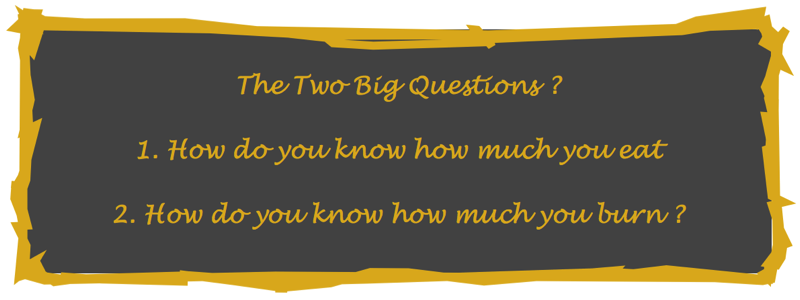
Most of the other diets start by assuming we are all too busy, or not motivated enough, or just not smart enough to understand or answer those two questions, so they "sugar coat" both with gimmicks (points, packaged meals, fixed recipes). Carnot takes advantage of science plus latest cooking and exercise technology (see below), plus the Cal-Index, Joule and simple rules that make a calorically reduced diet relatively easy and near painless. We answers the two big questions. The Burn question has become easy with electronic wireless activity gadgets and monitors (see FitBit) We teach you to cook with heathy ingredients that help reduce or suppress hunger. Carnot is sustainable because you learn to manage what you eat, and manage your own food while your losing weight and our goal is for you to answer both questions for the rest of your life. When someone starts planning meals with Joule they are shocked at what 2 TBS of olive does to a days diet, 100 grams of cheese on a salad, or 15 croutons on a salad. All are OK just need to know what it does to daily intake, not fool yourself. I love croutons but because they add so many calories, if I am going to have them I will make special great tasting croutons from simple ingredients not prepackaged, that are supper tasty gourmet - I do not buy the ones in the bag.
These are the four Carnot Diet Plan Rules. .
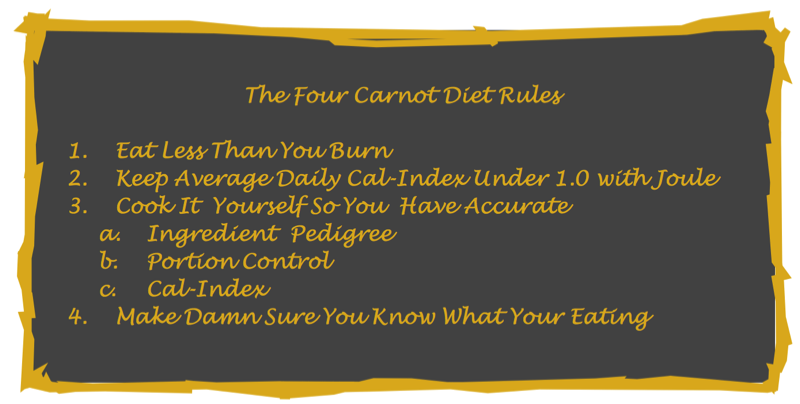
The first two weeks were most difficult weeks, but by week five or six weight loss became an easy habit.
This has been a five year war for me. I used the excuse that I was too tired at the end of the day to cook and way too busy as an executive to shop or worry about my weight - lot of excuses. I was skinny in graduate school, got married, became busy and when I hit age 50 I was class 1 obese. Now one year after I lost 80 lbs (see graph to right), I continue to use Joule, but spend less than five minutes a day entering data in my personal "Carnot Daily Table" (the CDT) for my food and am 185 lbs - normal weight and stable. Once your trained and understand the Carnot diet plan, learn how to estimate in/out calories, learn how to use Joule and graduate from the Carnot Culinary Academy, you will see cooking and managing your weight is just not difficult -- anyone can lose weight and maintain a target weight, cook and be healthy even if your too busy and too tired or rushed from work.
I have not regained any significant weight and do not expect to gain any, weight because I am Calorically Calibrated, I understand food and calories and my own nutrition, and will happily be on the plan for rest of my life.
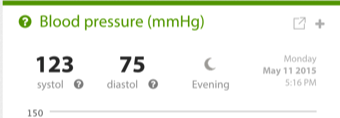
I get blood tests once a quarter and am normal for panel or 50 tests (click on image to right to see July 2014).
My Blood pressure is 75/123, the expected normal for 25 year old. Down from 90/147. I am convinced that elimination of my personal obesity has been responsible for my now great health. You can see my most recent poster boy panel Nov 2015 here - I am disgustingly healthy since I lost all that weight !!
The Rationale for the Cal-Index and Carnot Diet - Two Guiding Principles

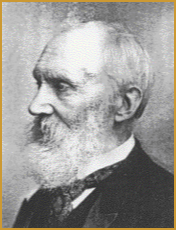
……… Okam's Razor - William of Okham - 14th Century
……… Lord Kelvin - 1856
Physics has an often quoted informal "law" known as Occam's razor, "les parsimoniae" based on writings of William of Okham, a 14th Century Franciscan friar and logician. The law says "the simplest thing is usually what is most likely to work". As you increase number of steps in any process, the risk of failure goes up. So if probability of success for a step is 80% and you have four steps, 0.8 * 0.8 * 0.8 * 0.8 = .409, that means it is 60% likely the process will fail. If you only have one step at it is only 20% likely that it will fail. It pays to make complex things simple.
Lord Kelvin was a british Physicists responsible for formalizing the physics of both the 1st and 2nd law of thermodynamics in the 1850's. He is well known for a quote also used by physicists, engineers and many others -- to paraphrase, "if you can not measure calories in and out you will never be able to manage your weight".
These two principles drove us to the Cal-Index a simple, single number tied to energy density for each food. Plus, we use the latest techno-gadgets and software tools and systems to measure weight, calories in and out accurately. No need for nutrient restrictions or micro-nutrient tracking or points. We data mined the USDA database and discovered that by keeping the average Cal-Index below 1.0 per day, you will not be deprived on any nutrients (see Nutrition tab). You will probably eat fruits vegetables to keep the average Cal-Index below 1.0, but potatoes, steaks, sauces, butter, bread, soft drinks, wine are all OK as well - no restrictions. Finally, we cook our meals using ingredients that have accurate, established and reliable caloric profiles - we call that Ingredient Pedigree, so we know the accurate Cal-Index and weight of any dish or meal.
Question: Why Does The Carnot Diet Work ? Answer: Because You Get To Eat Foods That Stop Hunger But Portion Control Calories -- Your in Charge so It is Sustainable.
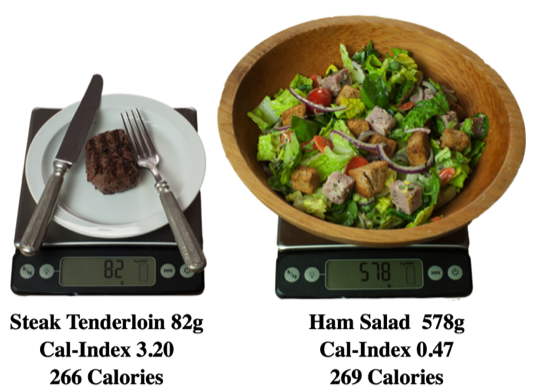
If you follow rule 1 and 2 you will lose weight with the added benefit, and after first three weeks, you won't be too too hungry all of the time. Again, you can eat any food you want including wine and alcohol, and be on any other diet plan as well and still follow these rules. For example, if you were on the Atkins diet you might have the 82g Tenderloin shown to the right. But you could have the 578g Ham Salad on the far right, both have same number of calories. Most eaters can't even finish the pound-and-quarter Ham Salad. The Salad has croutons, lots of ham, carrots, celery, onions, watercress, tomatoes, and a spicy dressing using greek yogurt and lemon juice. Both meals are about 270 calories.
However, many Atkins eaters would want more than just a 3 oz steak. With Carnot we show you how to cook grass fed, top round (Cal-Index 1.46) steak using Sous Vide, so you can have a 6.5 oz steak with the same 266 calories, that tastes just like a Tenderloin: and at half the price. That's what we call "Carnise" - take a dish, reduce calories and make it taste better, turn into a gourmet meal.
If you keep the days average Cal-Index below 1.0 with Joule you will get to eat more food, and you minimize feeling hungry. Towards the end of my diet, I ate an average of 5.2 lbs of food a day, my Cal-Index average was 0.67, I lost an average of 0.15 lbs per day and was rarely hungry. At the beginning of my diet I lost an average of .39 lbs a day and was always hungry, but that slowed down after I developed bunch of Satiety Snacks (see below).
When you feel sharp hunger pain your body is converting fat stores to glucose; you are losing weight, so it's not such a bad feeling. I try to be hungry at least 2 hours a day, it makes me feel healthy. Deep hunger leads most everyone to a high Cal-Index refrigerator forage..
Two new Carnot hunger habits:
1. Learn to enjoy and celebrate the pain of hunger, go for a walk or hike, activity helps, you'll feel healthy; Be hungry two hours a day, and you can be sure your eating less than you burn.
2. Make and eat low Cal-Index snacks; my favorites, low sodium pickles, kimchi, sour kraut, roasted yellow squash, roasted eggplant, roasted tomatoes, sous vide or poached apples, pears, kefir + corn bran, active culture yogurt, roasted asparagus, steamed artichokes, a light salad, steamed broccoli, umami miso soup, home made 4 bean salad, a few tiny little roasted potatoes, many others..
Palatability: Gourmet Cooking Technology (Techno-Gourmet) Improves Nutrition, Taste, Reduces Calories, Preparation Time, and Provides Accurate Portion Controls.
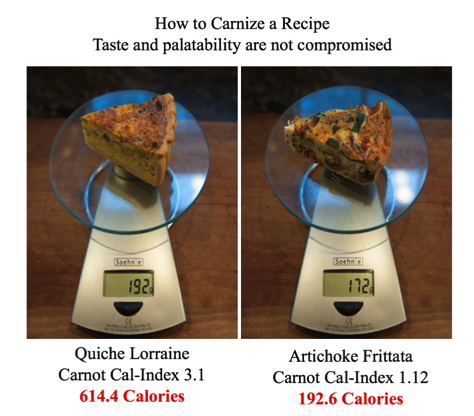
The Problem: Food palatability is usually managed by manufactures by adding unnecessary ingredients and calories. I ate the Quiche on the left at a business meeting and broke Rule 4 "Make Damn Sure You Know What Your Eating". I gained weight that day. The Quiche was made by a local catering company - so I called them up and asked what they used to make it. Three cups of cheddar cheese, few more cups of pavilion, eight eggs, plus breaded pie crust with butter ….. it all adds up to about 600 calories per slice - it tasted great…. However, it is loaded with fat because that's how commercial food producers make you like what you eat. They all usually add fat, sugar and salt " enhancers " to make it taste delicious us. On the right is an Artichoke Frittata that I made. It has been Carnised. That means unnecessary ingredients like the crust extra cheese, has been removed and it is portion controlled with a Cal-Index of 1.12, reduced from 3.1 for the Quiche - Both weigh about the same. But most people think my Frittata tastes better than the Quiche.
Make Ahead
Carnot Office Lunch Frittata;
172 calories, Cal-Index 1.04.
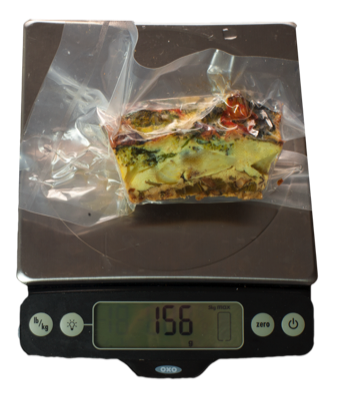
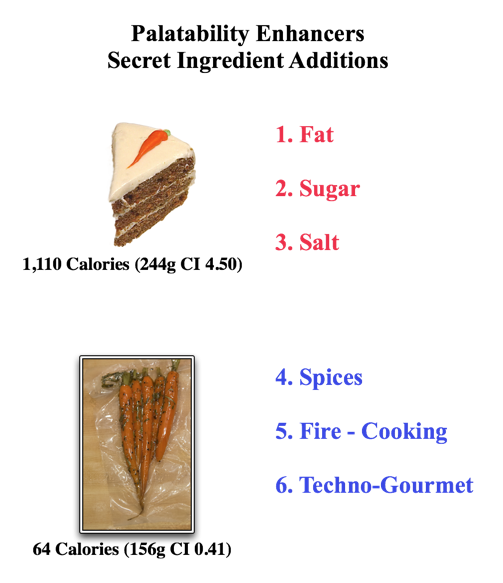
David Kessler in his book "The End of Overeating: Taking Control of the Insatiable American Appetite" really makes three important points; 1. The American food industry uses Fat Sugar and Salt to make our food more palatable and tasty. 2. That Fat Sugar and Salt leads to overeating and that has led to obesity in 30% of our population. 3. That obesity has created a healthcare crisis in America.
The history of eating has taught us two other important lessons. We can make foods more palatable and tasty with Spices and Heat-Cooking. With the skillful combination of Heat and Spices using Techno-Gourmet tools, the food becomes gourmet cuisine.
The good news - Spices and Heat do not add calories and do not lead to obesity, they are safe. Bee Wilson in her book "Consider The Fork", reviews the history of cooking and cuisine from 1.6m years ago, when Homo Erectus started fooling around with heat and fire, to today's latest technology. She explains how we got here eating the right and the wrong foods, and how spices and heat were so important to our cooking history.
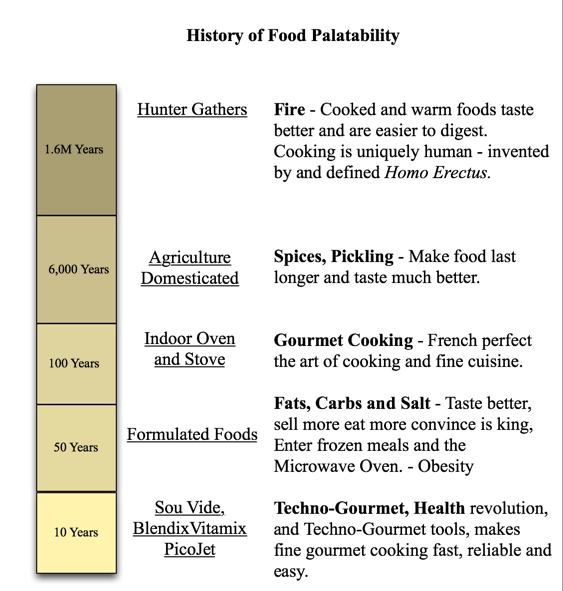
Technology Makes A Carnot Diet and Cooking Easier
The introduction of Techno-Gourmet Tools in the last decade may change history yet again, make it easy to skillfully add spices and add "heat" using simple healthy ingredients. It has other names. Jason Logsdon and Nathan Myhrvold call the new cooking technology "Modernist Cuisine", and in two recent books both provide recipes and open the world of food preparation technology for the home cook. Thomas Keller, the famous French Laundry founder and chef, in his recent book, "Under Pressure: Cooking Sous Vide, put food preparation technology (Sous Vide and PicoJet) on the reputable four star Michelin gourmet map.
Air Fryers made by several companies (e.g. Philips) use high speed hot air to "fry" or roast foods. An Air Fryer can roast vegetables with little or no oil in few minutes. Amazing how tasty roasted asparagus with garlic and thyme and 2 g of olive oil can be - cooks in 10 minutes, and is only about 50 calories per 200 g serving. I often roast a 64 cal gourmet snack, yellow squash - with bit of garlic thyme and 3 g olive oil tasty warm and filling.
Calorie reduced diets have been around for 100s of years, and have been feared by all. Simple straight up, lose weight with calorie reduced diets is viewed by most experts as brutal, too hard to maintain necessary discipline, impossible for most humans to execute. Especially if it includes cooking gourmet, portion controlled meals. However, over the last five years new technology not only make gourmet cooking quick and easy, but also make calorie reduced, portion controlled, healthy diets easy, and relatively painless, without pills without gimmicks.
In our view Techno-Gourmet is much broader than state-of-the-art, modern cooking tools. It includes other technical breakthroughs that we take for granted. They have all had major impact on my ability to lose and manage my weight and become healthy.
First; the world wide web explosion, with recipes, nutritional information, and food facts has been invaluable; connected iPads that can be used in the kitchen with 100s of useful apps; silicon coating of parchment paper (yes important); low cost high resolution load detectors so we have accurate digital scales (both bathroom, and kitchen scales) that have weight resolutions of 1:25,000 units; inexpensive induction cooking technology; modest cost, temperature controlled, water circulators, that are accurate to 0.1 degree; WiFi and LE Bluetooth enabled data logging activity monitors and scales (FitBit, Force, Fuelband, Pulse, UP, MIO Alpha, Shine, Play); blenders that have 2-3 HP motors with blades that rotate at 37,000 RPM; low cost; low maintenance no-oil, low cost, vacuum packers; HTML 5 that has made web applications useful (e.g. Google Spreadsheets); Online access to apps though inexpensive devices like the Google Chromebook; The Grocery industries expansion and focus on healthy ingredients, and whole foods over packaged production foods … Long list of devices in Carnot Gear section.
Techno-Gourmet cooking has been driven mainly by restaurant economics. Restaurant's do not want cooking a gourmet dish to cost much, cooking has to be convenient and as fast as possible (time is money), with food that requires minimal preparation skill, and must be portion controlled to reduce raw food costs. Those same requirements can also be used to make a calorie reduced Carnot Diet simple, and easy.
This "at home" lunch is one our favorites - we make it as a "dinner leftover lunch". It uses whatever we had for dinner the night before. Sous Vide Haddock, tomatoes, carrots and avocado. The two sauces transform this simple lunch into four star dinning. Prep time; 5 mins and 37 seconds, it is portion controlled with ingredients that have a verified caloric pedigree. I do not have to measure anything to make this - I am Calorically Calibrated and can guess "calories-in" accurately.
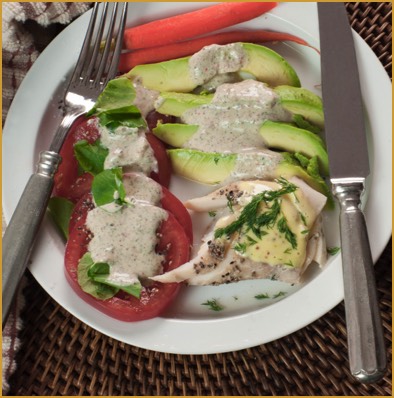
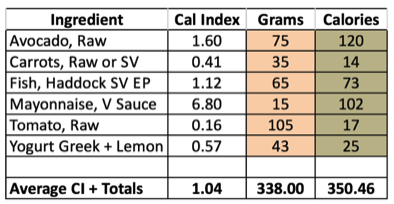
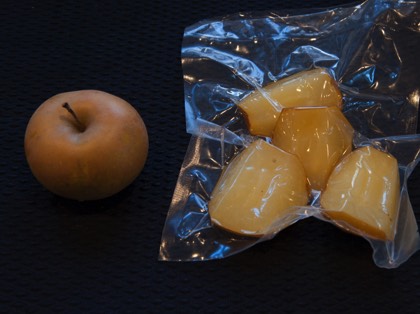
Over the last year I have interviewed about dozen males who have lost many pounds (as much as 100), and they all did it by staying hungry not eating much for maybe a year - That certainly works they followed Rule 1 with ruthless discipline; However if you enroll in The Carnot Culinary Academy and learn to Carnise and cook, it is not necessary to be hungry all of the time to meet Rule 1. I provide a long list of what I call "Satiety Snacks" in the Recipe tab using Techno-Gourmet tools. If you take a bunch of tomatoes, dump some spices on them, add some basil, wrap in parchment paper, put in microwave for 1 minute, you will have a snack that makes your hunger go away, but is only about 30 calories. That same dish, called "en Papillote Tomato Compote", is served as a gourmet side dish in many four star restaurants for $15-$20 and takes about 2 minutes to create.
My favorite Satiety Snack is Sous Vide pouched apple quarters with some cinnamon, Cal-Index 0.47, total about 66 calories. Again a dish that any gourmet restaurant might serve. Sous Vide cooking at 185F poaches the apples in their own juices, it is portion-controlled, pasteurized and everyone agrees has a wonderful flavor. I can prepare 50 organic apples ahead of time, and they will keep in refrigerator for many months, can be frozen and because apples are acidic (pH 3.0) OK at room temperature for days. You can make these with parchment paper (en Papillote) and cook in oven or microwave as well (see Recipes). Can also roast apples in an Air Fryer in about 10 minutes - again warm apples are tasty and help satisfy your hunger - only about 70 calories with 4 g fiber.
Joule - Your Personal Carnot Daily Table (the CDT) - Your Daily Menu
| No. | Food | Cal Index | Break | Lunch | Dinn | Snack | Calories |
|---|---|---|---|---|---|---|---|
| Totals Calories For 12/12/13 | 1232 | ||||||
| 1 | Coffee Black | 0.04 | 0 | ||||
| 2 | Chicken Stock, Low Cal | 0.04 | 0 | ||||
| 3 | Lettuce | 0.11 | 0 | ||||
| 4 | Zucchini | 0.13 | 0 | ||||
| 5 | Celery, Raw (add yorgert spice dressing) | 0.15 | 150 | 23 | |||
| 6 | Cucumber with Skin | 0.15 | 0 | ||||
| 7 | Endive, SV | 0.16 | 100 | 16 | |||
| 8 | Radish, White | 0.16 | 0 | ||||
| 9 | Asparagus, Steamed | 0.18 | 0 | ||||
| 10 | Drink, V8 Vegetable Juice | 0.18 | 300 | 54 | |||
| 11 | Pickle, Dill or half Sour | 0.18 | 100 | 160 | 47 | ||
| 12 | Tomato | 0.18 | 0 | ||||
| 13 | Vinegar, White | 0.20 | 0 | ||||
| 14 | Vinegar, Wine | 0.20 | 0 | ||||
| 15 | Mushrooms, Cultivated | 0.21 | 156 | 33 | |||
| 16 | Salad, tossed cucumbers, carrots | 0.22 | 0 | ||||
| 17 | Spinach | 0.23 | 0 | ||||
| 18 | Cauliflower, Cooked | 0.25 | 225 | 56 | |||
| 19 | Tomato, Stewed | 0.26 | 0 | ||||
| 20 | Artichoke hearts canned brine | 0.27 | 0 | ||||
| 21 | Turnup, SV | 0.27 | 0 | ||||
| 22 | Red Peppers, Roasted | 0.30 | 0 | ||||
| 23 | Vinegar, Champagne | 0.30 | 0 | ||||
| 24 | Mushrooms, Chanterelle, or Wild | 0.31 | 0 | ||||
| 25 | Onions, Yellow | 0.32 | 0 | ||||
| 26 | Strawberries, fresh raw | 0.33 | 0 | ||||
| 27 | Broccoli, Boiled Steamed | 0.35 | 0 | ||||
| 28 | Chicken Stock,Packaged | 0.36 | 0 | ||||
| 29 | Salad, Diet ham or chicken or tuna | 0.36 | 0 | ||||
| 30 | Tonic Water, Non-Diet | 0.37 | 350 | 130 | |||
| 31 | Onions - Frozen Birds Eye White Pearl | 0.38 | 0 | ||||
| 32 | Buttermilk, or Milk | 0.40 | 0 | ||||
| 33 | Brussel Sprouts, Steamed | 0.41 | 0 | ||||
| 34 | Carrots, Raw or SV | 0.41 | 0 | ||||
| 35 | Celery Root SV , CELERIAC | 0.42 | 0 | ||||
| 36 | Beets, SV | 0.43 | 0 | ||||
| 37 | Butternut Squash | 0.45 | 0 | ||||
| 38 | Artichokes, Steamed, SV | 0.46 | 0 | ||||
| 39 | Apple, Granny Smith, (Pear) SV | 0.47 | 0 | ||||
| 40 | Drink, Vitamix, or Orange Juice | 0.50 | 0 | ||||
| 41 | Rasberries | 0.53 | 0 | ||||
| 42 | Yogurt Greek | 0.57 | 0 | ||||
| 43 | Soup, Vitamix Roasted Tomato | 0.60 | 0 | ||||
| 44 | Fish, Flounder PP | 0.69 | 0 | ||||
| 45 | Cheese, Cottage Cheese Low Fat | 0.70 | 0 | ||||
| 46 | Sunchokes, Jerusalem Artichoke | 0.72 | 0 | ||||
| 47 | Parsnips, Raw | 0.75 | 0 | ||||
| 48 | Green Peas, frozen boiled | 0.78 | 0 | ||||
| 49 | Wine, white dry | 0.80 | 435 | 348 | |||
| 50 | Fish, Scallops | 0.86 | 0 | ||||
| 51 | Potatoes, Sweet Raw | 0.86 | 0 | ||||
| 52 | Vinegar, Balsamic | 0.86 | 0 | ||||
| 53 | Fish Lobster | 0.88 | 0 | ||||
| 54 | Banana | 0.90 | 0 | ||||
| 55 | Mayonnaise, Hellmann's Low Fat | 1.00 | 0 | ||||
| 56 | Fish, Tuna Steak, Yellow Fin | 1.09 | 0 | ||||
| 57 | Rice, white | 1.10 | 0 | ||||
| 58 | Chicken Breast no Skin | 1.11 | 0 | ||||
| 59 | Frittata, Ham Cheese Vitamix | 1.12 | 0 | ||||
| 60 | Fish, Haddock SV | 1.12 | 213 | 239 | |||
| 61 | Fish, Salmon Lean, Organic Farm | 1.16 | 0 | ||||
| 62 | Frittata, Cheese Vitamix (No Ham) | 1.17 | 187 | 219 | |||
| 63 | Ham Steaks | 1.25 | 0 | ||||
| 64 | Potatoes, Baked, | 1.30 | 0 | ||||
| 65 | Sandwich Cheese | 1.34 | 0 | ||||
| 66 | Fish, Halibut SV | 1.40 | 0 | ||||
| 67 | Ice Cream, Low Fat | 1.43 | 0 | ||||
| 68 | Steak, Grass Fed Organic SV | 1.46 | 0 | ||||
| 69 | Fish, Trout Farm | 1.48 | 0 | ||||
| 70 | Garlic, Raw | 1.49 | 0 | ||||
| 71 | Egg, Boiled | 1.55 | 0 | ||||
| 72 | Fish, Swordfish | 1.55 | 0 | ||||
| 73 | Ice Cream, Yoplat Yogert | 1.57 | 0 | ||||
| 74 | Avocado, Raw | 1.60 | 0 | ||||
| 75 | Chicken Stock,Knoor Cubes. No liquid | 1.66 | 0 | ||||
| 76 | Garlic, Roasted With Olive Oil | 1.80 | 0 | ||||
| 77 | Steak, Tenderloin | 1.80 | 0 | ||||
| 78 | Chicken Breast with Skin | 2.00 | 0 | ||||
| 79 | Fish, Muscles | 2.00 | 0 | ||||
| 80 | Fish, Salmon Fatty Wild | 2.06 | 0 | ||||
| 81 | Lamb Chops | 2.08 | 0 | ||||
| 82 | Steak, Flank | 2.25 | 0 | ||||
| 83 | Steak, Ribeye Fat Trimed | 2.25 | 0 | ||||
| 84 | Protein Bar, Quest | 2.44 | 0 | ||||
| 85 | Bread, Wheat | 2.50 | 0 | ||||
| 86 | Quaker Oatmill | 2.50 | 0 | ||||
| 87 | Sauce, Lemon, or Other | 2.50 | 0 | ||||
| 88 | Cheese, Goat | 2.67 | 0 | ||||
| 89 | Cheese, mozzarella | 2.78 | 0 | ||||
| 90 | Steak, Ribeye | 2.91 | 0 | ||||
| 91 | Stuffing | 3.00 | 0 | ||||
| 92 | Cream, Heavy | 3.33 | 0 | ||||
| 93 | Cheese, Cream Cheese | 3.42 | 0 | ||||
| 94 | Cheese, Swiss | 3.78 | 0 | ||||
| 95 | Cinnamon | 3.80 | 0 | ||||
| 96 | Cheese, Cheddar | 4.03 | 0 | ||||
| 97 | Pistachios | 5.33 | 0 | ||||
| 98 | Cashews | 5.84 | 0 | ||||
| 99 | Olive Oil, or other oil | 6.00 | 4 | 24 | |||
| 100 | Sesame Seeds, Roasted | 6.10 | 0 | ||||
| 101 | Almonds | 6.11 | 0 | ||||
| 102 | Chopped Walnuts | 6.25 | 0 | ||||
| 103 | Butter | 7.17 | 0 | ||||
| 104 | Bacon, Roasted, (Bacon Fat) | 8.90 | 0 | ||||
| 105 | Butter, GHEE Clairified | 9.00 | 5 | 45 |
On the left you see the list of foods and meals I eat all of the time with the Cal-Index. The Cal-Index is simply the calories contained in one gram of the food on the left. It is often a shock to discover that number for a favorite food. For example Almonds, have Cal-Index of 6 plus, that means you get 6 calories for each gram, or about 90 calories from a tablespoon (15 grams) - that's is just a quick tiny little snack. Also we have sometimes two entries for the same thing. Fish; Salmon can be lean or fat. You can think you eating a 150 calorie fillet, when actually it is close to 350 or 400 calories. Part of becoming a Carnot Ninja is to learn how to estimate the caloric content before you eat it.
The USDA lists over 7,900 foods in a large data base (go to USDA Tab). That original database includes the number of calories per 100 grams for every item listed, however the the Cal-Index is it is easy to remember and makes it easy to company energy density of foods. All you have to do is multiply the weight of what you ate times the number you see on the scale in grams times the Cal-Index and you know how many calories you consumed.
You can download the spreadsheet log Click Here.
What about Exercise ? Cooking Can be Great Exercise !!
Exercise and high activity levels are important in any weight loss program. But it does not have to be an hour work out at a gym, or a 5K run everyday. In fact many studies have shown that exercise will increase appetite and in the end be counterproductive. But if you walk a mile and weight 180 Lbs you will burn about 110 calories. If you stay active all day, don't just sit in a chair as you work, can burn 300-500 extra calories. The Mayo-Clinic has shown Nonexercise Activity Thermogenesis (NEAT) can help increase weight loss (see Levin NEAT). The Mayo program simply suggests that you walk around your office when making phone calls and stand at your desk to create extra NEAT activity. NEAT simply means you keep moving all day, maintain a high level of mobility. You really do not burn too many more calories walking a mile at 2.5 mph, vs 3-4 mph, you just do it faster. We address this topic in detail in the
I use a FitBit One only to count steps and use that as an indicator of activity each day. I do not use the Fitbit web site for calorie calculations - it is not accurate, but the Fitbit steps per day is quite accurate. Cooking takes a lot of energy and is a great way to increase those NEAT calories. (see youTube NEAT Video ). I try to keep my activity calories above 500 per day, and I record them in my daily log in Joule. On a weekend when I am often in the kitchen most of the day, I can burn over 700 activity calories and walk over five miles just cooking.
What About Vitamins Minerals and Micro-Nutrients ?
Adding another thing to track especially in the early stages of any weigh loss program, will increase likelihood of failure. We have data mined both our own daily menus and the USDA data base (see Nutrients tab) and discovered that as long as you eat everything you want to eat and maintain an average Cal-Index below 1.0 each day you should have a balanced healthy diet, lose weight with no deficiencies. In other words it is not necessary especially in the first few months to worry about or track vitamins, minerals, macro-nutrients or micro-nutrients. I do not track, but I do pay special attention to fiber and salt (Na) content and discuss those details in the Nutrients tabs.
One caveat; After listening to Michael Pollan's recent book "In Defense of Food An Eater's Manifesto" for the third time, and reading "Still No Free Lunch" by Brian Halwell, a 2007 report published by the Organic Center, I am concerned about the accuracy of the USDA data base for many critical nutrients. He reviews the scientific literature as well as the USDA's own studies that show caloric density and crop yields of fruits, vegetables, wheat, corn, soy beans beef and poultry over the last century. At the same time as yields and caloric content go up in these foods, the data are overwhelming that the nutrient density of the same foods has gone down in some cases by 2 to 3 times over the last 100 years. This has all been though selective breeding, driven by economics and commercial pressure. We discuss this in detail in the Nutrient tab.
I would recommend buy organic "heritage" fruits and vegetable products when possible, to be on safe side as often as you can as additional insurance. We provide several recipes that make low cost, grass fed beef with a Cal-Index 1.4, taste just as good and as tender as high fat, expensive tenderloins with Cal-Index of 3.5 using Sous Vide cooking.
What About Beer, Wine and Alcohol (ETOH) ?
You can have beer, wine and mixed drinks with Carnot. Most other diet plans limit Alcohol, based on the wild imaginary idea that it is going to make you fat. Common belief is ETOH creates an imbalance and is a special "nutrient". Pure Alcohol has a Cal-Index of 7.0, but most drinks are diluted down to a CI of 0.8 or less. But again it is treated as if ETOH has special calories that are going to make you fat - none of that is true.
For example, Weight Watchers counts one point per oz of wine. So a 4 oz glass of wine is four (4) points. That translates to about 140 calories using the old WW points system. Wine has a Cal-Index of 0.80 and a 4 Oz glass of wine is 112 g. That means it is really 90 calories of energy not 140. More important, ETOH gets burned up immediately and does not go to fat, ETOH calories have no simple path to long term fat storage. Just no science anywhere that supports treating alcohol special over fats carbs or protein - none (see Calissendorff 2008, Weststrate et. al 1990 for reviews see Wine Diet Science Tab for details).
When I lost 80 lbs, I carefully counted wine's caloric content, just like food, without ever cutting back on what I normally drink per night. I love my wine. The evidence is it does not lead to weight gain - just include it in your Joule CDT tab as part of your diet. One 6 oz glass is 168 g with CI of 0.80 thats 134 calories - don't cheat. Wine is a good low cal diet drink with Cal-Index of 0.80…. I switched from white wine to red wine after I lost all my weight, and learned I tend to drink less red wine over white, plus my blood pressure went down (it is 82/128 now from 85/147). More about this latter.
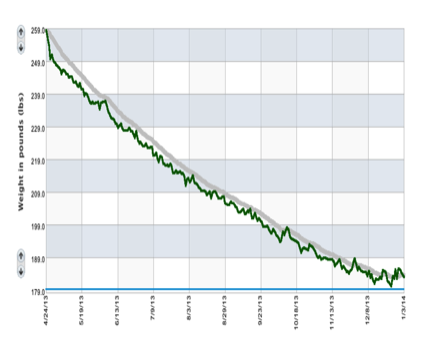
My 8 Month Weight Graph
I lost 80 lbs on the Carnot Diet from April 2012 to December 2012. Several friends and colleagues asked for Carnot material. This site is my attempt to organize and share that material and what what I have learned. This is not a commercial site.
The Carnot
Sidebar Dictionary
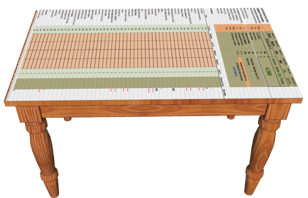
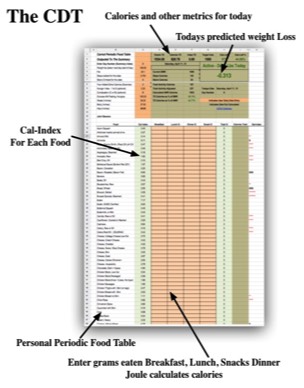

Nicolas-Sadi Carnot, The Father of Thermodynamics
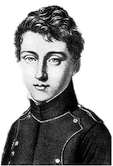
"Hell Hath No Furry Like A Body Cheated of Calories" …. Carnot's 5th Law of Thermodynamics.

